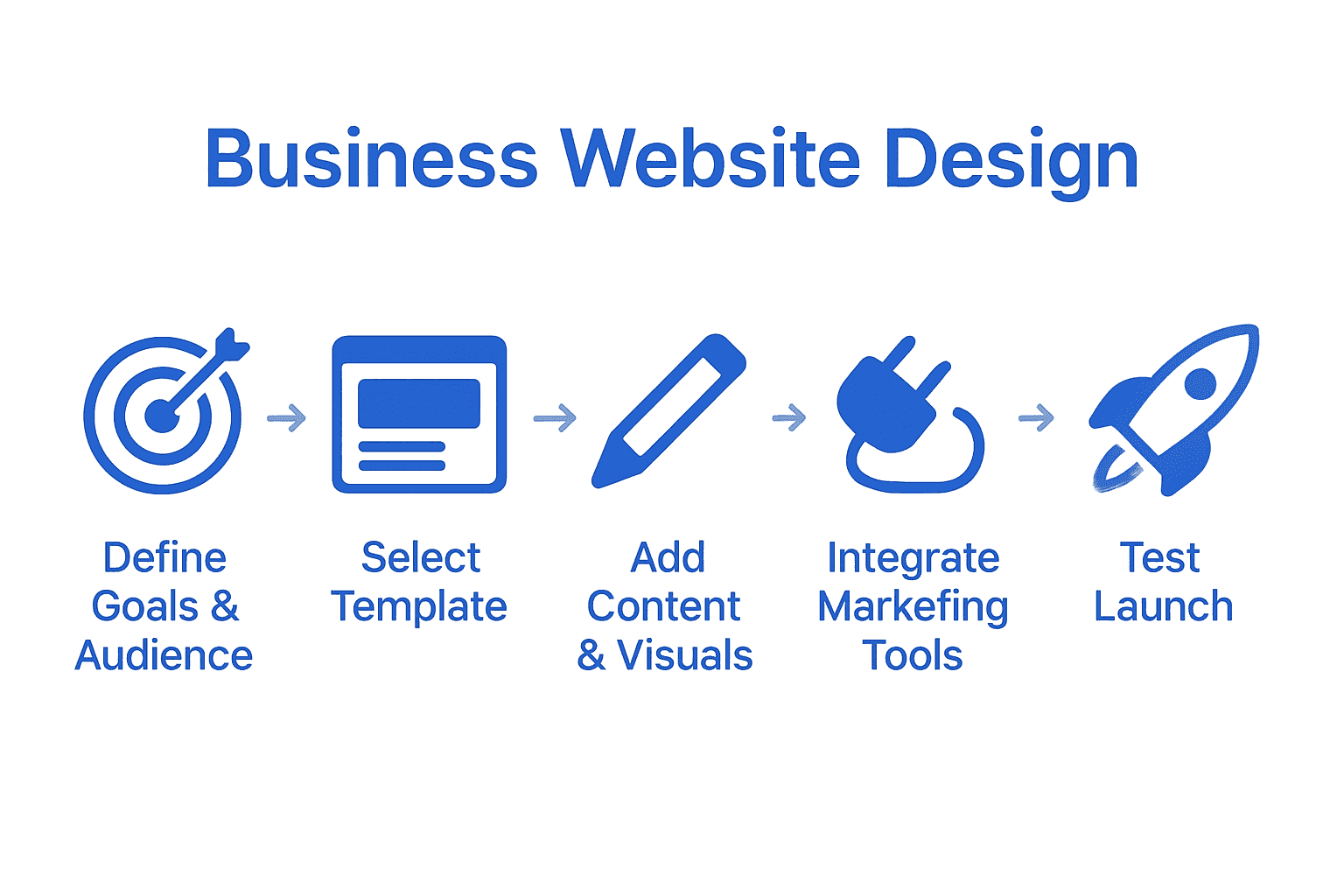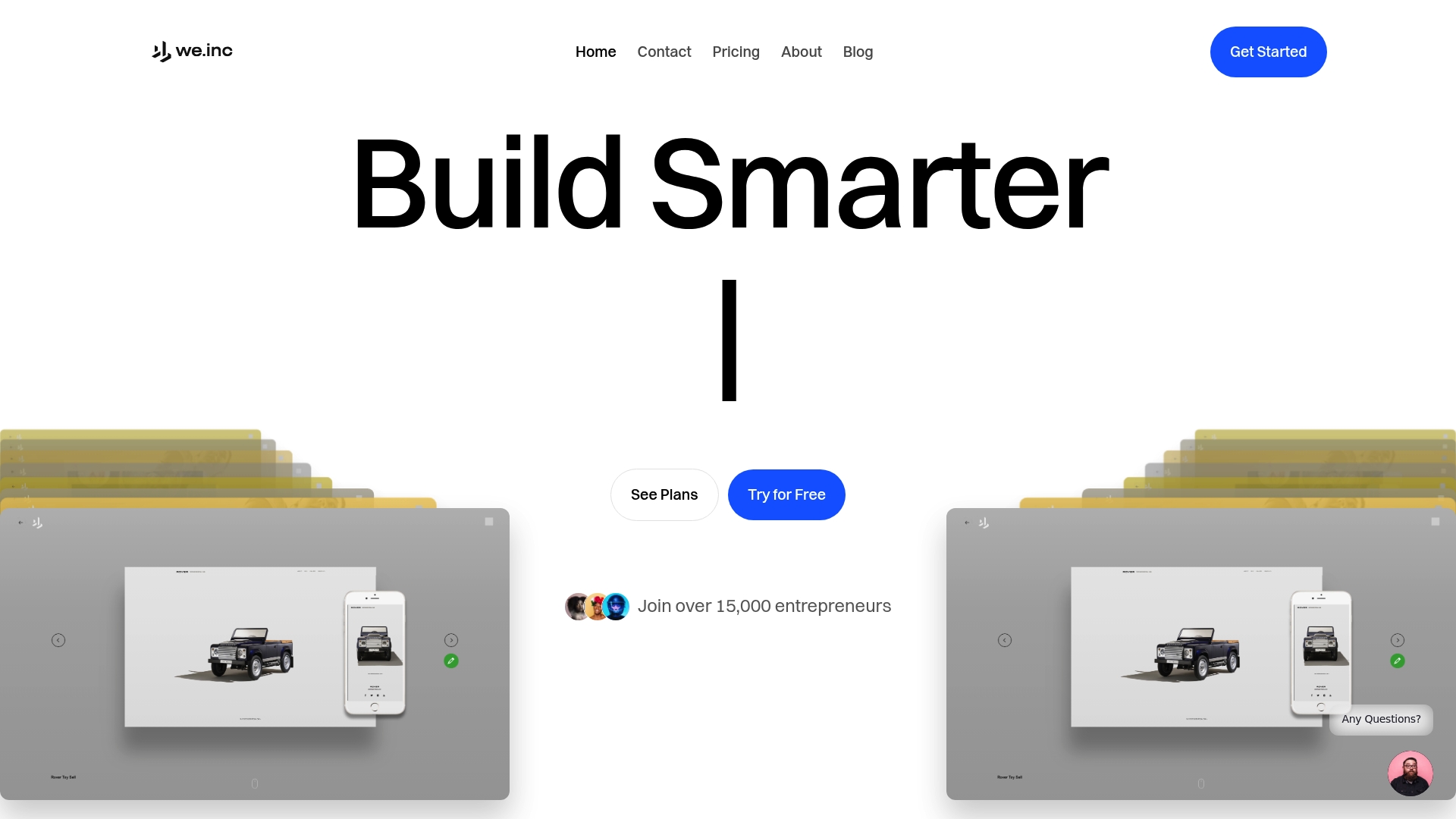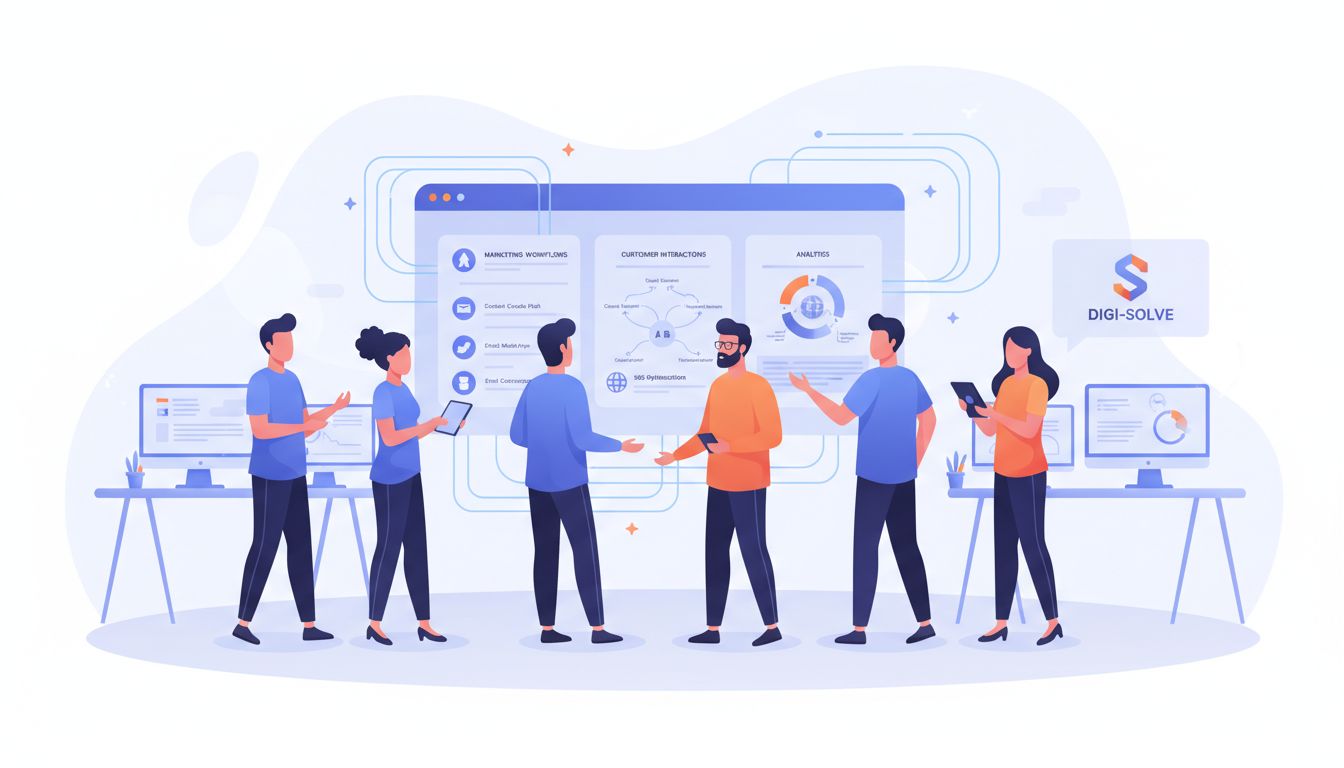Step by Step Website Design for Business Success

Did you know that businesses with clear website goals are up to 30 percent more likely to convert visitors into customers? Defining your objectives and truly understanding your audience is the difference between a site that simply exists and one that drives growth. Discover how purposeful planning, smart design choices, and strategic content turn your website into a powerful tool that delivers results and stands out from the crowd.
Table of Contents
- Step 1: Define Website Goals And Audience
- Step 2: Select And Customize A Template
- Step 3: Add Essential Content And Visuals
- Step 4: Integrate Sales And Marketing Tools
- Step 5: Automate Engagement And Social Posts
- Step 6: Test And Launch Your Website
Quick Summary
| Key Point | Explanation |
|---|---|
| 1. Define specific website goals | Clarify what your website aims to achieve, such as generating leads or selling products. |
| 2. Understand your target audience | Create detailed buyer personas to align content and design with user needs. |
| 3. Choose functionality over design in templates | Prioritize templates that enhance user experience and business objectives. |
| 4. Craft strategic content and visuals | Ensure your messaging and images convey your unique value and engage users. |
| 5. Automate social media engagement | Use automated tools to streamline postings while maintaining a personal touch. |
Step 1: Define website goals and audience
Every successful website starts with crystal clear goals and a deep understanding of your target audience. According to Columbia University, establishing an editorial mission helps guide all content decisions and ensures your website effectively serves its intended purpose.
To begin defining your website goals, ask yourself critical questions: What specific business objectives will this website help you achieve? Are you looking to generate leads, sell products, showcase your portfolio, or provide information? The United Nations recommends creating a comprehensive planning approach that articulates your primary purpose and target audience needs.
Start by creating a simple goal statement that is specific, measurable, and aligned with your broader business strategy. For example, instead of a vague goal like “get more customers,” craft a precise objective such as “increase qualified lead generation by 25% within six months through targeted service pages and strategic call to action buttons.” This level of specificity transforms your website from a digital brochure into a powerful business growth tool.
Understand your audience deeply by developing detailed buyer personas. Consider demographics, professional roles, pain points, and online behaviors. What information are they seeking? What problems do they need solved? Your website design and content should speak directly to these specific audience segments.
A helpful tip: Always prioritize your audience’s needs over your own preferences. Just because you like a design element does not mean it serves your target users effectively. Test your assumptions and be willing to adjust based on user feedback and analytics.
Ready to move forward? Building a Business Website Step by Step for Success will guide you through the next crucial stages of website development.
Try it free at We.inc and start building your business website today.
Step 2: Select and customize a template
Choosing the right website template can transform your digital presence from ordinary to extraordinary. According to University of Wyoming, modern templates are designed to be accessible, professional, and consistent with your brand identity.
When selecting a template, prioritize functionality over aesthetics. As University of Wisconsin-Extension recommends, your chosen template should align closely with your organizational goals and audience expectations. Look for templates that offer clean layouts, responsive design, and easy navigation.
Consider these key factors during template selection: mobile responsiveness, color customization options, font flexibility, and built-in features that match your business needs. A nonprofit organization will have different template requirements compared to an ecommerce store or professional service provider.
Think strategically about your template. It is not just about looking good but creating an intuitive user experience that guides visitors toward your desired action whether that is making a purchase, scheduling a consultation, or signing up for a newsletter.
A critical tip: Always preview your template on multiple devices and screen sizes. What looks perfect on a desktop might become unreadable on a smartphone. Test thoroughly before committing.

Ready for the next step? How to Build Agency Website That Converts Fast provides additional insights into creating a high-performance website.
Try it free at We.inc and start building your business website today.
Step 3: Add essential content and visuals
Transforming your website from a blank template to a compelling digital experience requires strategic content and visual planning. According to University of Washington, effective content must serve a clear purpose and meet specific audience needs.
University at Buffalo emphasizes that content and visuals should directly align with your business strategic goals. Start by crafting clear concise messaging that communicates your unique value proposition. Your homepage should instantly answer three critical questions for visitors: Who are you? What do you offer? Why should someone choose your business?
When selecting visuals, prioritize high quality professional images that represent your brand authentically. Avoid generic stock photos that feel impersonal. Instead, use original photography showcasing your team, workspace, products, or actual client interactions. Each visual should tell a part of your business story and create an emotional connection with potential customers.
Consider your content hierarchy carefully. Place the most important information front and center. Use headings subheadings and short paragraphs to make your content scannable. People rarely read websites word for word they scan for relevant information quickly.

A critical tip: Write conversationally and avoid industry jargon. Speak directly to your target audience as if you were having a one on one conversation. Your goal is to build trust and demonstrate that you understand their specific challenges.
Ready to elevate your website design? The Essential Guide to Visual Website Builders offers additional insights into creating a compelling online presence.
Try it free at We.inc and start building your business website today.
Step 4: Integrate sales and marketing tools
Powering your website with strategic sales and marketing tools transforms your online presence from a static brochure to a dynamic business engine. According to NTEN, successfully integrating online marketing tools requires carefully aligning them with your specific organizational goals to enhance outreach and engagement.
Commonwealth of Learning highlights the importance of integrating tools that enhance website functionality and user interaction. Start by identifying key performance indicators that matter most to your business such as lead generation conversion rates or customer acquisition cost. Look for tools that provide robust analytics tracking email marketing capabilities customer relationship management features and automated follow up sequences.
Consider implementing AI powered marketing tools that can streamline your workflows. These advanced solutions can help segment your audience personalize communication and automate repetitive marketing tasks freeing up your time to focus on strategic growth. Features like chatbots email automation and predictive analytics can significantly improve your marketing efficiency.
When selecting integration tools prioritize seamless compatibility with your existing systems. The goal is creating a smooth interconnected ecosystem where data flows effortlessly between different platforms. Test integrations thoroughly and ensure they provide clear measurable insights that help you make informed business decisions.
A critical tip: Start small and scale gradually. Do not overwhelm yourself by implementing every possible tool at once. Choose 2-3 core tools that directly address your most pressing business needs and master them before expanding your marketing technology stack.
Ready to supercharge your digital marketing approach? 7 Essential AI Marketing Strategies for Digital Growth provides deeper insights into leveraging cutting edge marketing technologies.
Try it free at We.inc and start building your business website today.
Step 5: Automate engagement and social posts
Transforming your digital marketing strategy means moving beyond manual posting to smart automated engagement. According to National Coalition of STD Directors, digital platforms offer powerful strategies for automating social media interactions to reach broader audiences efficiently.
University of Wisconsin-Extension emphasizes the importance of integrating automated social media functions to streamline content delivery and enhance user engagement. Begin by selecting a social media scheduling platform that allows you to plan and publish content across multiple channels simultaneously. Look for tools that offer features like content calendar management post preview analytics and audience segmentation.
AI powered social media automation can dramatically improve your marketing efficiency. Create a content library with pre written posts tailored to different platforms and audience segments. Schedule posts during peak engagement times set up automatic responses for common customer inquiries and use predictive analytics to understand optimal posting frequencies.
Consider developing a content mix that balances promotional material educational content and interactive posts. Use scheduling tools to maintain consistent brand presence without requiring constant manual intervention. Track engagement metrics to continuously refine your social media strategy and understand what resonates most with your audience.
A critical tip: Automation does not mean impersonality. Always maintain a human touch by periodically reviewing and responding to comments personalizing automated messages and staying authentic in your brand communication.
Ready to master social media automation? Social Media Scheduling Explained: Automate Engagement and Growth provides comprehensive insights into effective social media strategies.
Try it free at We.inc and start building your business website today.
Step 6: Test and launch your website
Bringing your website from concept to reality requires meticulous testing and strategic launching. University of Kansas emphasizes the critical importance of analyzing your site’s purpose and audience before going live to ensure it meets organizational goals.
ERIC Research Document highlights best practices in website development that include comprehensive testing to guarantee functionality and user satisfaction. Start by conducting thorough cross browser and cross device testing. Verify that your website looks and performs consistently on desktop computers tablets and mobile phones. Check all interactive elements like forms buttons and navigation menus to confirm they work seamlessly.
Perform usability testing by having real users navigate your website and provide honest feedback. Pay attention to load times page responsiveness user interface intuitiveness and overall user experience. Use analytics tools to track user interactions and identify potential friction points that might discourage visitors from engaging with your content.
Before launching create a comprehensive backup of your entire website. Double check all links make sure contact forms are routing to the correct email addresses and verify that payment gateways security certificates and other critical integrations function correctly. Consider creating a soft launch where you invite a limited group of trusted users or stakeholders to preview and provide feedback.
A critical tip: Never consider your website a finished product. Continuous improvement based on user feedback and performance metrics is key to long term digital success. Plan for regular reviews and updates to keep your website fresh and aligned with evolving business goals.
Ready to take the final step? Step by Step Website Launch Guide for Entrepreneurs offers additional insights into a smooth website deployment.
Try it free at We.inc and start building your business website today.
Unlock Your Business Potential with Seamless Website Design and Automation
Building a high-converting website can feel overwhelming when faced with decisions about goals, templates, content, and marketing tools. The article highlights common challenges such as defining precise objectives, selecting user-friendly templates, integrating sales and AI-driven marketing, and automating social engagement. These are critical steps every entrepreneur or agency must master to turn a website into a true growth engine. If you want to break through these hurdles without technical headaches, you need a solution that combines all these essentials in one place.

Experience how We.inc empowers you to create stunning, conversion-focused websites fast without any coding skills. Our platform merges website building with AI-powered marketing automation and social media scheduling so you can focus on growing your business instead of juggling multiple tools. Ready to take control and launch your success story today Get started now by exploring Building a Business Website Step by Step for Success to learn how to plan your site and then jump straight into action at We.inc. Your digital growth toolkit awaits.
Frequently Asked Questions
What should I consider when defining website goals for my business?
To define effective website goals, start by identifying specific business objectives such as increasing leads, showcasing products, or providing valuable information. Write a goal statement that is specific and measurable, like “increase qualified lead generation by 25% within six months.”
How do I choose the right website template for my needs?
Select a template that prioritizes functionality over aesthetics by looking for mobile responsiveness, easy navigation, and alignment with your business goals. Test different templates across devices before making a final decision to ensure they meet user expectations.
What content should I prioritize when building my website?
Focus on clear, concise messaging that communicates your unique value proposition right away. Use high-quality, authentic visuals that resonate with your audience and ensure the most important information is easily accessible and scannable on your site.
Which marketing tools should I integrate into my website?
Implement marketing tools that align with your organizational goals, such as email marketing, analytics tracking, and customer relationship management features. Start with two or three core tools that address your immediate needs and expand as you become comfortable with their functionalities.
How can I automate social media engagement for my website?
Utilize social media scheduling platforms to automate your posts and engagement across multiple channels. Create a content library with tailored posts and schedule them for peak engagement times to improve consistency and reach without manual effort.
What testing should I conduct before launching my website?
Conduct thorough cross-browser and cross-device testing to ensure functionality and user satisfaction. Test all interactive elements and gather real user feedback to identify areas of improvement before the official launch.
%20(1).svg)


